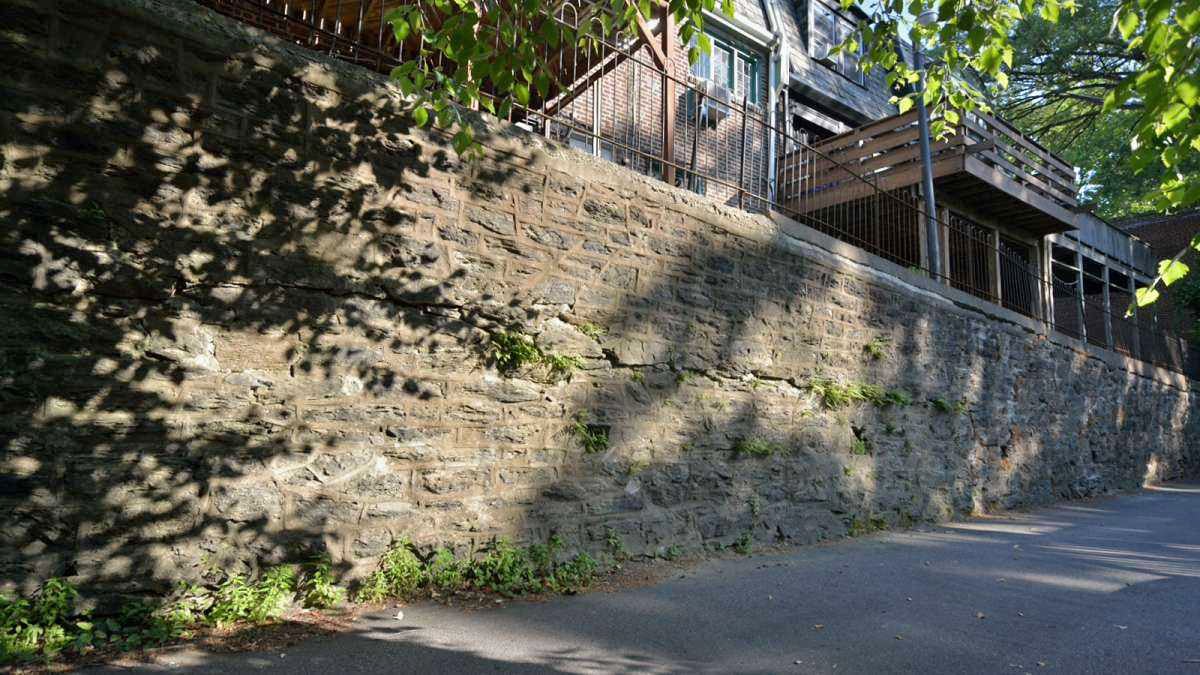For neighbors with shared walls and alleys, who takes care of repairs?

Sections of a 550-foot-long retaining wall in the East Falls neighborhood of Philadelphia are leaning, cracked, and unsafe, affecting the owners of 65 homes on either side of the wall. (Bas Slabbers/for NewsWorks, file photo)
It’s difficult when neighbors have to share. It’s even more difficult when what they share is broken.
In Philadelphia, a recent WHYY/NewsWorks story reported, there are 78 privately owned common walls in serious needs of repair in neighborhoods across the city. An 85-year-old, deteriorating wall in East Falls affecting 65 homeowners would cost $500,000 to shore up. The neighbors can ill afford the bill, and are having trouble figuring out who would be responsible for how much.
The Department of Licenses & Inspections sent the neighbors building code violation notices – since rescinded, for the time being – that would be added to the $6,923 cost each would bear if the city had to step in and hire a contractor to make the repairs.
But the East Falls scenario isn’t even in the top ten list of worst cases in Philadelphia. The city is staring at $22 million in wall repairs, and no funds set aside to make them.
The neighbors in Philadelphia aren’t the only Pennsylvanians who have to deal with problems of shared property. Fortunately, other municipal governments don’t have property maintenance issues on the same scale as Philadelphia, and they seem to have coping measures in place.
Familiar slopes
The crumbling walls in Philadelphia are mainly found in its older, hilly sections, where developers used retaining walls to build level lots, backyards and parking areas.
But Philly’s topography has nothing on Pittsburgh, a city built on the Appalachian Plateau. Pittsburgh’s elevations range from 710 feet where the three rivers meet to 1,300 feet at its highest points. It’s a city of hills and hollows, accessible by steep streets, inclines and public steps.
But it’s also a city whose residents have come to terms with the challenges of the changing terrain, according to Maura Kennedy, formerly of Philadelphia’s Department of Licenses & Inspections and, since last year, Pittsburgh’s chief of the Bureau of Building Inspections.
“We have a ton of retaining walls because of our topography,” Kennedy told Keystone Crossroads, “but we actually find very few problems with them.”
As in Philadelphia, residents of Pittsburgh are held responsible for maintaining the piece of the wall that runs through their property. And they apparently do it on a regular basis.
Because the city land is so uneven and the shared walls so common, “people are used to maintaining them,” Kennedy said, and the municipal government has not stepped in to pay for repairs when the walls start to crack or lean. “It’s just the basic responsibility of living in a hilly place,” she said.
“There also seems to be more emphasis on individual property rights here. So it’s natural to take on your own responsibility for your property.”
Dispute enforcement
The city of Lancaster doesn’t have the same topographic challenges as the Commonwealth’s large cities to the east and west. But it does have to cope with sometimes uncooperative property owners.
Gary Horning, Lancaster’s bureau chief of Code Compliance and Inspections, said the city recently had to deal with the case of a four-foot retaining wall in need of immediate repair.
“The dispute was over the property line” and who was responsible for what. “So we had a survey done and found the problem transcended both property lines.”
The city does not take on the cost of repairs to shared private property, Horning said. “What we do is identify the responsible owners, and then use enforcement procedures to get the necessary repairs made.”
Back alleys
In York, the problems of common property occur in the usually unseen parts of a neighborhood: private alleys.
Jim Gross, the director of York’s Department of Public Works, said that alleys shared by multiple owners are shown little love and care.
The level of maintenance by the owners depends on how actively they are used, Gross said. “If they aren’t accessed very much, they don’t do anything. If they do use them, they find a way to maintain them.”
In most cases, the city of York does not step into the alleys.
In other cases, such as shared garages, “if code enforcement issues come into play, the city does enter the picture,” Gross said. “If a property is deemed unsafe, we’ll go in and bring it down.”
Back in Philadelphia, Streets Commissioner David Perri is working with other city departments to find a funding formula to repair shared property.
The first preference is to have property owners take on regular maintenance themselves, as they do in Pittsburgh.
For residents who can’t afford the repair costs, other models, including loans and real estate surcharges, are being considered to solve the problems of sharing common property.
Contact the writer at alanjaffe@mac.com
WHYY is your source for fact-based, in-depth journalism and information. As a nonprofit organization, we rely on financial support from readers like you. Please give today.


